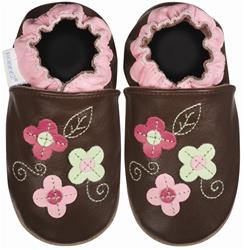
How old should a baby starting to wear shoes? To answer that question lets learn something interesting about the development of the baby’s feet. Babies are born with only 22 of the 26 bones they will eventually have in their feet. Their feet also have a more soft tissue than bone, making them vulnerable for injury and malformed. So you should only put infant shoes on your baby’s feet when going out and leave them barefoot whenever possible, this way their feet can grow naturally and healthily. When selecting baby shoes and socks for your baby, make sure they are loose fit so there will be room for your baby’s feet to grow. If you can tickle your baby’s feet and toes a few times daily, the flexing and scrunching reaction by your baby will allow the feet to build strength and promote better growth. Shoes are necessary when your baby is starting to walk outside. At this point, podiatrists recommend baby shoes that are flexible and lightweight, with soft, nonskid soles. A good pair of baby shoes will protect your baby’s fragile feet while allowing her to learn how to balance.
To pick the perfect pair of infant shoes for your baby you need to consider the fitting, softness and protective function of the shoes, you should also consider if you want to get a pair of conventional baby shoes or pair of natural baby shoes. Conventional shoes come in many styles. Among those, miniature running shoes, hiking boots, sandals and other stylish footwear are very tempting to parents, but who could imagine that these children’s shoes are sewn or glued together with synthetic, un-breathable materials and are definitely not the best for wee feet. Most of these shoes are made with potential harmful materials and their designs are for style and look. They are not flexible at all to allow for ideal foot growth. What is worse is that many of these shoe manufacturers do not care about the fact that babies are often put their feet in their mouths, even while they have their shoes on. Either way, harmful materials from these shoes, such as BPA, glue and adhesive materials can all lead to your baby’s body through mouth intake.
So what should you do about that you may ask? The solution is the healthier option, “Natural Baby Shoes”. The best choice of baby shoes is a leather shoe made in Europe that comes in various color and pattern selections. Leather used in making of baby shoes is tested for toxicity and must meets the British and European safety standards before it is allowed to be sold in the market. Same standards are not found anywhere in the United States as we speak and hopeful soon the standard will be adopted in North America. Shoes that meet the stricter European standards for toxicity standards will give you a level of comfort and confidence that you no longer have to keep your eyes on your baby to stop her from putting her feet into her mouth. Not all shoes are made the same even when they look the same so research the company before you place your purchase. For non-walking babies, there are fleecy cotton shoes and booties on the market that come with an adjustable snap or string-pull closure to fit your baby’s feet for several months. The design of these cotton shoes will prevent your baby from pulling them off easily but at the same time allow some breathing room for your baby’s feet to grow comfortably.
